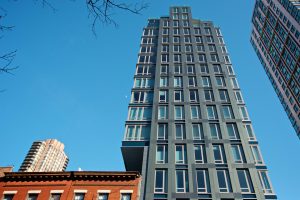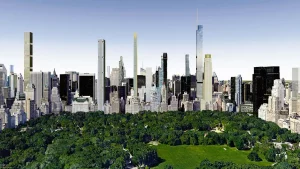How Do Air Rights Work in NYC Real Estate in 2025?
Go Back To Previous PageWhen you have a place like New York City, everything has a protocol, a fee, or even a particular process or concept. Even something along the lines of air or “space above” can have a specific way of being parsed. That’s why air rights in NYC are a thing, but what does this mean in the Big Apple? Air rights are the space above your apartment building or condo. Like how companies treat carbon emissions rights, entities can buy or sell air rights. Only a set number of those rights are available for each part of the city. If you are a building owner, it makes sense to understand what these rights offer you and how developers can use them. You might be shocked to hear the truth about NYC’s city planning! How do you buy air rights in NYC?
What Are Air Rights?
Air rights in NYC refer to the space above or around a building used for development. If a building is 50 feet tall but could be as high as 75 feet, the unused 25 feet are referred to as unused development or air rights. The owner of this building could potentially add additional stories or sell their unused airspace to an adjacent building, which would then allow the construction of a taller building by combining the development rights from both lots.
In the past, New York City was all about building upwards rather than outwards, which isn’t good in large quantities.
Building too high would make the city unbearably dense, not to mention significantly darker. People balked, so they developed the concept of air rights in NYC.
Air rights are rights over the space above your apartment’s rooftops. In New York, this includes the right to develop a building upwards, and each area receives specific rights transferrable from building to building.
How Are Air Rights Typically Determined?
Air rights are a combination of things; the most critical factor is the Floor-Area Ratio.
What is the Floor-to-Area Ratio (FAR)?
The floor-to-air ratio refers to the maximum square footage that can be built on a lot relative to its square footage. FAR is calculated by dividing the total floor area of a zoning lot by the lot area on the single zoning lot.
For example, a building with 25,000 SqFt on a lot with a lot area of 5,000 SqFt has a FAR of 5 (25,000 SqFt / 5,000 SqFt). Permitted FAR varies by zoning district, location, and building use. This is how much floor space you have compared to your lot’s area. In some districts, people are given less area than in others.
Air rights are essential for developers, multi-use property owners, townhouses, condo and co-op buyers and sellers, and real estate brokers. They are also called Unused Development Rights, Excess Developments, Transferred Development Rights, and Available Development Rights.
Air rights are determined by applying the Zoning Resolution to a zoning lot.
How Can You Tell If Your Property Could Be Further Developed?
New York City is pretty fussy about how buildings can be developed. Because air rights are such a hot topic in this city, the government created a regularly updated map illustrating where those rights currently rest and where buildings are marked as “totally done.”
currently rest and where buildings are marked as “totally done.”
For an existing building, the amount of unused development rights equals the maximum gross floor area permitted in the zoning lot where the building is located minus the amount of floor area utilized by the existing structure(s).
The City of New York’s zoning resolution (ZR) determines the extent of permitted development rights for each zoning lot. Specifically, the Zoning Resolution regulates the size, height, setbacks, lot coverage, and yards of buildings and other structures in NYC.
How Are NYC’s Air Rights Transferred?
Honestly, it’s not like you can sell your rights like most people would oil rights. There are three standard methods by which air rights in NYC are transferred. Each has its process, often assisted by lawyers:
- Zoning Mergers occur when two building owners join their property into one contiguous area. Their air rights are compounded, so instead of two 6-story additions, they could make one sizeable 12-story addition.
- Special Purpose Transfers. These occur when building owners from non-connected buildings transfer their rights to create a particular interest tower or similar usage item. For example, this was a thing for the Hudson Yards.
- Landmark Transfers. You can do a landmark transfer to be a socialite and create a new landmark. This allows you to sell your air rights so the landmark gets built, often as an act of generosity.
How Are Air Rights in NYC Labeled?
Those rights show how many more square feet you can add to the top of your building. So, if every floor is 10,000 square feet, those rights that total 20,000 square feet would allow you to add two more floors to the top of your building.
How Much Do Air Rights Cost?
Citywide, air rights currently cost $225 per square foot. However, the price in your area can be exceptionally pricey or cheap, depending on the local land costs.
on the local land costs.
On the Upper East Side, this can be as pricey as $400 and up or as little as $100 per square foot.
It’s worth noting that most parts of the city will have more expensive airspace than the actual floor space. This is because the potential for development often comes at g a premium price.
Other documents required to effectuate a transfer of unused development rights include:
- Declaration of Zoning Lot Restrictions
- Zoning Lot and Development Agreement (ZLDA)
- Title Company Certification
- Zoning Lot Description and Ownership Statement by Building Department Applicant
- Department of Buildings – Plan/Work Approval Application
Is It Possible To Get More Air Rights In New York City?
Maybe soon. The NYCHA owns the lion’s share of the air rights, and over 80 million square feet of unused, unsold air space are part of its holdings. Depending on how things go, New York might see many square feet used in transactions.
How do you buy air rights in NYC?
The release of that air space is part of the city’s 10-year plan to encourage expansion and innovation and improve the rent crisis. Whether or not this will bode well for the city depends on many factors. However, it’s safe to say that we’ll see building up frequently.
How Do You Know How Much Air Rights A Building Has In NYC?
This is tricky, but there’s some good news. Air space is documented as part of a building’s materials, so when a listing occurs, the agent has to search for building rights.
Similarly, you may need to talk to a brokerage or a real estate lawyer to sell building rights.


